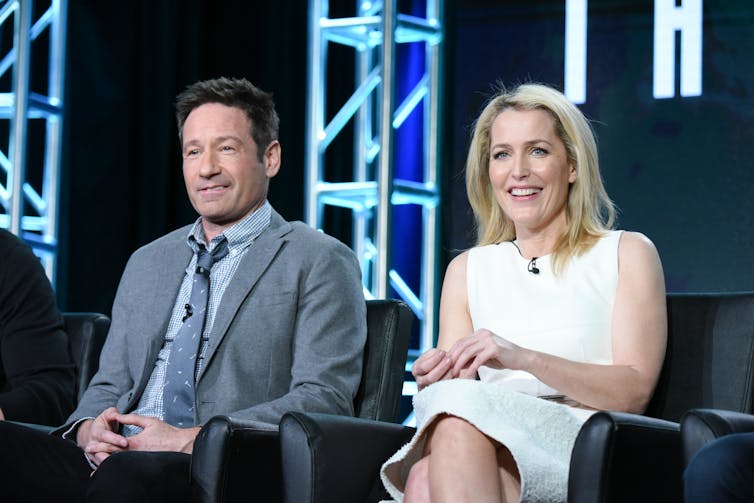Exploring the data on Hollywood's gender pay gap
A new analysis of over 400 actors shows that gender discrimination plays a major role in Hollywood salaries.

Audiences were furious to hear that Michelle Williams was paid eight times less than Mark Wahlberg for her starring role in “All the Money in the World” and 1,500 times less for reshoots. He was paid US$1.5 million for reshoots, while she received less than $1,000.
But has the gender pay gap for Hollywood actors been blown out of proportion from a few cases cherry-picked by the media? If there is a difference in salary between men and women, can it be explained not by sex discrimination but rather by variation in actor quality and film characteristics?
My analysis with my former student Taylor Milana of over 400 actors in more than 100 movies from 1984 to 2018 indicates the answer to both of these questions is no.
Discrimination does play a role in Hollywood salaries.
Pay inequality
A recent national comparison of average salaries indicates that women in the U.S. earn approximately 80% as much as men.
In the film industry, the gender pay gap appears to be significantly larger. In 2017, a comparison of the highest-paid male and female actors revealed an average salary of $57.4 million for men and $21.8 million for women. That means that top female actors earn 38% as much as the top male actors.
That’s a striking difference that reveals a need for careful, empirical investigation.
Existing studies of actors’ salaries have a few important shortcomings. Salary comparisons have usually been derived from small samples, so we can’t be certain the gap would exist with a more representative sample.
What’s more, a comparison of average salaries doesn’t account for differences in quality that could justify earnings differences. For example, an actor who has been honored with an Oscar or with a track record of attracting large theater audiences would understandably earn more than an actor without these accomplishments.
Earnings disparities between groups are not necessarily the result of discrimination, even if the individuals are working in the same occupation. In some cases, differences in earnings can be explained on the basis of merit; in other words, factors like differences in worker skill and work intensity can influence differences in wages.
Studies disagree on exactly how much of a role discrimination plays in the gender wage gap nationally. When data is drawn from workers in many occupations and industries, discrimination appears to play a significant role in the pay gap.
However, in studies that focus on specific occupations and industries, such as corporate executives, where workers are likely to be engaged in more similar tasks, the role of discrimination appears negligible.

Our investigation
We believe our study uses the largest sample of actor salaries that has been compiled to analyze earnings in the film industry.
We started with the Internet Movie Database, where we gleaned all reported salaries from 1984 to 2018, as well as the actor’s gender and race, along with movie budget and genre information.
We found that the salary gap is about 45%. In our sample, the average salary is $6.6 million for women and $11.9 million for men.
This wage gap is considerably larger than the national average and larger than has been previously estimated for actors using anecdotal evidence from the highest-profile actors.
Nevertheless, the unadjusted salary gap doesn’t account for differences in actor quality and film characteristics. So, these figures can lead to misleading implications about discrimination.
We also collected data from Box Office Mojo, a box office revenue tracker; The New York Times; and the Academy Awards Database. Our dataset includes numerous actor and movie characteristics, including the movie’s budget and genre; New York Times rank of importance in a film; the number of Academy Awards earned; and the box office revenue generated in all movies that included the specific actor.
After controlling for these differences, we discovered that, at most, 29% of the $5.3 million salary difference between men and women can be explained by actor and film characteristics.
That is, about $3.8 million, or 71%, of the difference is unexplained by the characteristics we looked at – a sign of potential discrimination.
In comparison to other studies that focused on specific occupations and industries, this is really high.
Discrimination debate
Economists disagree over how accurately one can estimate the rate of discrimination.
Some argue that certain characteristics are not observable or measured, and so the effect of discrimination will look bigger than it actually is. Others note that individuals may willingly make choices that have negative effects on their salary. For example, it’s been argued that women are more likely to sacrifice salary for a job that has flexible hours, offers child care or better health benefits. Is it possible that in our setting women are more likely than men to choose roles in romance or comedy over high-budget action films?
The other side of the coin is that the unexplained component of the gap might understate discrimination. Do women sometimes choose careers because they don’t think they’ll be hired in the areas that they are truly passionate about, or because they have been pressured to believe that they can’t be successful in some fields? Are women choosing smaller-budget films, or are they being pushed in that particular direction?
If preexisting discrimination influences the “choices” researchers observe, then the explained difference is overstated and discrimination is understated.
I think both sides of the debate have merit. But, in the end, the evidence is clear to us: Discrimination plays a big role in Hollywood.
[ Like what you’ve read? Want more? Sign up for The Conversation’s daily newsletter. ]
Roberto Pedace tidak bekerja, menjadi konsultan, memiliki saham, atau menerima dana dari perusahaan atau organisasi mana pun yang akan mengambil untung dari artikel ini, dan telah mengungkapkan bahwa ia tidak memiliki afiliasi selain yang telah disebut di atas.
Read These Next
As DOJ begins to release Epstein files, his many victims deserve more attention than the powerful me
Powerful men connected to Jeffrey Epstein are named, dissected and speculated about. The survivors,…
People are getting their news from AI – and it’s altering their views
Even when information is factually accurate, how it’s presented can introduce subtle biases. As large…
Local democracy is holding strong, but rural communities are falling behind, new survey of Michigan
Officials from 70% of Michigan’s 1,856 cities, villages, counties and townships completed the survey.






